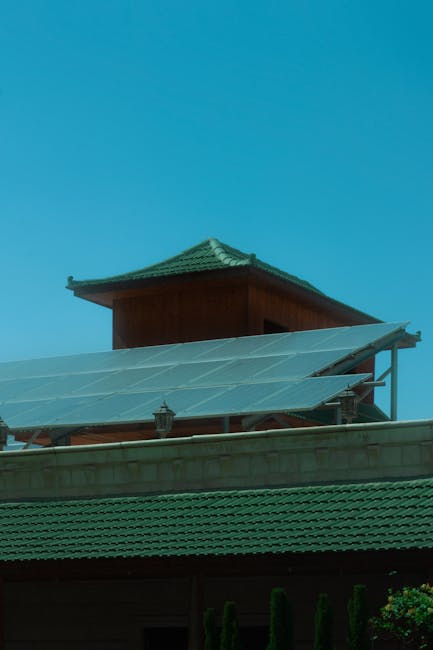Do Solar Panels Keep Roof Cooler?
As the world increasingly turns to renewable energy sources, solar panels have become a popular choice for homeowners looking to reduce their energy bills and carbon footprint. However, many people wonder about the additional benefits of solar panels, particularly whether they can help keep roofs cooler. In this article, we will explore the relationship between solar panels and roof temperature, the science behind it, and the broader implications for energy efficiency and climate control.
The Basics of Solar Panels
Before diving into how solar panels can affect roof temperature, let’s first understand what solar panels are and how they work.
- Definition: Solar panels are devices that convert sunlight into electricity. They are typically made of photovoltaic (PV) cells that generate power when exposed to sunlight.
- Types of Solar Panels: There are mainly two types of solar panels: monocrystalline and polycrystalline. Monocrystalline panels are more efficient but often more expensive, while polycrystalline panels are less efficient but more affordable.
- Installation: Solar panels are usually installed on rooftops, where they can receive maximum sunlight exposure throughout the day.
How Solar Panels Affect Roof Temperature
Now that we have a basic understanding of solar panels, let’s explore how they can influence the temperature of the roofs they are installed on.
1. Shade and Insulation
One of the primary ways solar panels can keep roofs cooler is by providing shade. When solar panels are installed, they create a barrier between the sun and the roof surface. This shading effect can lead to a significant reduction in the temperature of the roof. Here’s how:
- Reduced Heat Absorption: Roofs, especially those made of dark materials, tend to absorb a lot of heat from the sun. By shading the roof, solar panels can prevent this heat absorption.
- Improved Air Circulation: The space between the solar panels and the roof allows for better air circulation, which can further help in dissipating heat.
2. Thermal Mass Effect
Solar panels can also influence the thermal mass of a roof. Thermal mass refers to a material’s ability to absorb and store heat. When solar panels are installed, they can change how heat is distributed across the roof surface.
- Heat Distribution: Instead of allowing heat to build up in the roof material, solar panels can help distribute heat more evenly, preventing hot spots that can lead to increased temperatures.
- Lower Roof Surface Temperature: Studies have shown that roofs with solar panels can be significantly cooler than those without, especially during peak sunlight hours.
Benefits of Cooler Roofs
Keeping roofs cooler has several benefits, both for homeowners and the environment. Let’s take a look at some of these advantages.
1. Energy Efficiency
A cooler roof can lead to lower energy consumption for cooling systems. Here’s how:
- Reduced Air Conditioning Costs: When roofs are cooler, the indoor temperature of a home can remain lower, reducing the need for air conditioning.
- Increased HVAC Efficiency: Air conditioning systems do not have to work as hard to cool the home, leading to longer lifespans and lower maintenance costs.
2. Extended Roof Lifespan
Excessive heat can damage roofing materials over time. By keeping roofs cooler, solar panels can help extend the lifespan of roofing materials.
- Reduced Thermal Expansion: Materials expand and contract with temperature changes. Cooler roofs experience less thermal stress, which can lead to fewer cracks and leaks.
- Less Wear and Tear: A cooler roof is less likely to suffer from heat-related damage, such as curling shingles or deteriorating membranes.
3. Environmental Impact
Cooler roofs contribute to a reduction in the urban heat island effect, which is a phenomenon where urban areas become significantly warmer than their rural surroundings.
- Lower Ambient Temperatures: By reducing the overall temperature of buildings, solar panels can help lower the ambient temperature in urban areas.
- Improved Air Quality: Cooler temperatures can lead to reduced energy consumption, which in turn can decrease air pollution from power plants.
Considerations for Homeowners
While the benefits of solar panels in keeping roofs cooler are clear, there are some considerations homeowners should keep in mind.
1. Installation Quality
The effectiveness of solar panels in cooling roofs largely depends on the quality of the installation. Poorly installed panels may not provide adequate shading or insulation.
- Choose Experienced Installers: Always opt for reputable solar panel installation companies with positive reviews and certifications.
- Regular Maintenance: Ensure that solar panels are regularly cleaned and maintained to maximize their efficiency.
2. Roof Material
The type of roofing material can also influence how effective solar panels are at keeping roofs cool.
- Reflective Materials: Roofs made of reflective materials can further enhance cooling effects by reflecting sunlight away.
- Dark Materials: Dark roofs absorb more heat, so pairing them with solar panels can be particularly beneficial.
3. Local Climate
The effectiveness of solar panels in cooling roofs can vary based on local climate conditions.
- Hot Climates: In hotter regions, the cooling effect of solar panels can be more pronounced.
- Cooler Climates: While still beneficial, the impact may be less significant in cooler areas where air conditioning is used less frequently.
Conclusion
In summary, solar panels do indeed help keep roofs cooler by providing shade, improving air circulation, and altering heat distribution. This cooling effect not only benefits homeowners by reducing energy costs and extending roof lifespan but also contributes positively to the environment by mitigating the urban heat island effect.
As more people consider solar energy as a viable option, understanding the additional benefits of solar panels can help in making informed decisions. If you’re thinking about installing solar panels, remember that they can be a smart investment for both your wallet and the planet.




